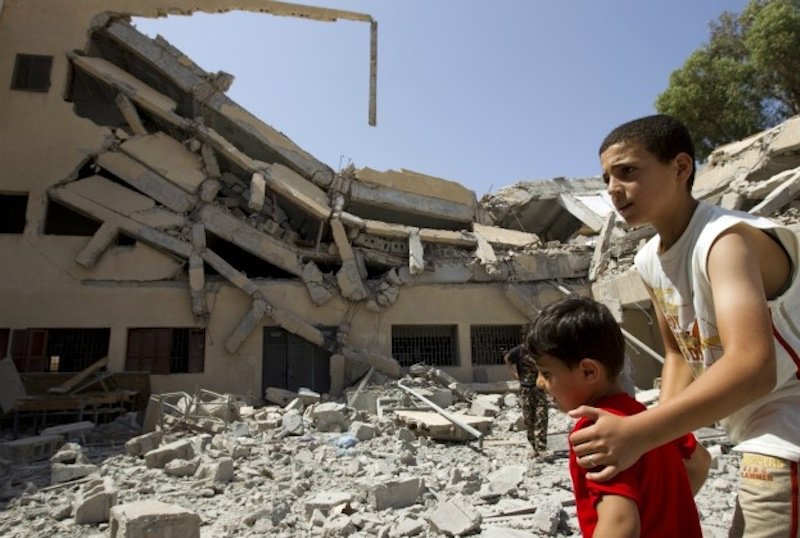
The U.S. persistently uses bombs to try to solve the very problems its own bombs created
The U.S. dropped at least 23,144 bombs on six Muslim-majority countries in 2015 — Iraq, Syria, Afghanistan, Pakistan, Yemen and Somalia.
The government has not officially declared war in Syria, Pakistan, Yemen or Somalia, but this hasn't stopped it from bombing them, or from waging a secretive drone war in Pakistan, Yemen and Somalia for more than a decade.
Yet it appears these wars are not enough. The Obama administration is "on the verge of taking action" against ISIS in Libya, Sen. Bob Corker, the chairman of the Senate Foreign Relations Committee, told Politico.
The U.S. insists it does not plan to deploy ground troops to the oil-rich North African country, but Obama said the same thing about Iraq and Syria, and there are now 3,700 American soldiers in the former and scores of special operations forces in the latter.
In an attempt to normalize the proposed intervention, the White House pointed out in a daily press briefing that it has actually already carried out airstrikes in Libya since the 2011 NATO war.
The notion that the U.S. is considering another bombing campaign in Libya in order to fight ISIS is almost laughably ludicrous, because it was in fact the first U.S.-backed bombing campaign in Libya that brought ISIS into the North African nation in the first place.
Comment: Must reads:
As Salon stressed in a piece about the escalation toward the new war in Libya, the disastrous 2011 NATO bombing of Libya plunged the country into chaos. Today, in the aftermath, there is no functioning federal government, and large swaths of the country are now controlled by rivaled factions and extremist groups.
There are presently estimated to be 5,000 to 6,500 ISIS fighters in Libya. There were zero before the U.S.-backed war.
In the mean time, thousands of Libyans have been killed, and hundreds of thousands are fleeing, seeking refuge elsewhere.
Hawkish Democratic presidential candidate Hillary Clinton played a pivotal role in this war, essentially leading it as secretary of state. The Washington Post reports that she has since "repeatedly defended the Libya military intervention as U.S. 'smart power at its best.'"
When Libyan dictator Muammar Gaddafi was sodomized with a bayonet by rebels, Clinton gloated live on TV, declaring "We came, we saw, he died."
The real Benghazi scandal is that the once bustling city is in ruins today, in the wake of the NATO war, with large chunks of it under the control of extremist group Ansar al-Sharia.
The situation in Iraq is very similar. Al-Qaeda was not in Iraq before the illegal 2003 U.S.-led invasion, and ISIS did not even exist. The catastrophic U.S. war and occupation dissolved the government, fueled violent sectarianism, destabilized the region as a whole and led to the deaths of more than 1 million Iraqis.
U.S. intelligence agencies have admitted that, despite spending an average of $9.4 million on bombing ISIS in Iraq and Syria, its airstrike campaign, when isolated from ground forces like the Kurds, has been ineffective.
A French journalist formerly held captive by the extremist group has even warned that "strikes on ISIS are a trap," insisting "with the bombings we are more like pushing people into the hands of ISIS," rather than weakening it.
American military intervention in Afghanistan has been much the same. "The Taliban now control more of Afghanistan than at any time since October 2001," journalist Antony Loewenstein, an author of numerous books and Guardian columnist who has spent time in Afghanistan and neighboring Pakistan reporting on the U.S. war and occupation, told Salon in a forthcoming interview about his book "Disaster Capitalism."



Comment: The U.S. bombing of Libya at this juncture would satisfy several objectives:
1. Create more chaos for Europe where most refugees are attempting to find safe haven; thereby destabilizing, dividing and helping to "conquer" Europe towards imperial ambitions.
2. Justifies military industrial complex expenditures in the hundreds of $Billions.
3. Attempts to make it look like the U.S. is doing something effective in the war on ISIS.
4. Temporarily satisfies an unquenchable thirst for chaos and the death and destruction of mostly innocent people.